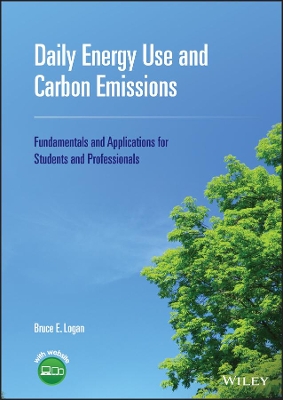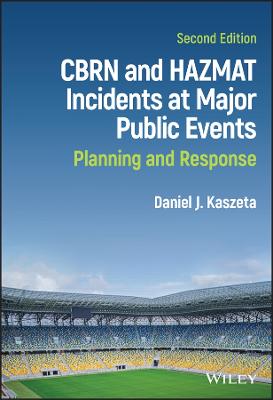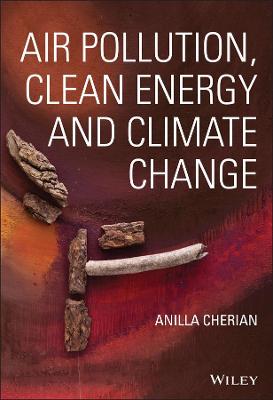Daily Energy Use and Carbon Emissions
 -15%
portes grátis
-15%
portes grátis
Daily Energy Use and Carbon Emissions
Fundamentals and Applications for Students and Professionals
Logan, Bruce E.
John Wiley & Sons Inc
01/2022
288
Dura
Inglês
9781119831013
15 a 20 dias
718
Descrição não disponível.
Preface ix
1. Introduction 1
1.1 A Very Brief History of Energy Use 1
1.2 Early Energy and Power for Transportation and Electricity Production 2
1.3 Energy and the Challenge of Global Climate Change 4
1.4 Looking to the Future: The Age of Electro-MechanicalChemical Energy Conversion and Storage 7
1.5 Why D, C, and w Units? 10
References 12
2. Energy Use 15
2.1 Units of Energy and Power 15
2.2 Comparing Different Energy Units Using kWh 19
2.3 Energy Use in the US with a Focus on Climate Change and the Future 21
2.4 Energy Use Around the World 32
2.5 Next Steps 33
2.6 How Much Energy Should We Use? 34
References 35
3. Daily Energy Unit D 37
3.1 Defining the Daily Energy Unit D 37
3.2 Examples Using D 39
3.3 Primary Energy Consumption When Using Electricity in Units of D 44
3.4 Your Life in D Units 46
3.5 Energy and Electricity Used Compared to Fossil Fuel Use By Different Countries 48
3.6 Creating Green D 51
References 53
4. Daily CO2 Emission Unit C 55
4.1 Defining the Daily Carbon Emission Unit C 55
4.2 CO2 Emissions From Different Fuels 58
4.3 Emissions of CO2 for Delivered Electricity 60
4.4 Carbon Emissions for People in Units of C 62
4.5 Reducing Global CO2 and Other GHG Emissions 65
References 70
5. Daily Water Unit w 73
5.1 Engineered and Natural Water Systems 73
5.2 Water Use and the Daily Water Use Unit w 74
5.3 Energy Use for Our Water Infrastructure 76
5.4 Energy Use for Water Treatment 80
5.5 Energy for Used Water Treatment 82
5.6 Desalination 84
5.7 Energy Storage Using Water 85
5.8 CO2 Emissions and Project Drawdown Solutions 88
References 89
6. Renewable Energy 91
6.1 Introduction 91
6.2 Solar Photovoltaics 91
6.3 Wind Electricity 96
6.4 Geothermal Electricity 100
6.5 Biomass Energy 101
6.6 Hydrogen Gas Production using Renewable Energy 106
6.7 Costs of Renewable versus Conventional Energy Sources 110
6.8 Energy Storage in Batteries 111
6.9 Impact of Renewable Energy on Reducing Carbon Emissions 113
References 114
7. Water - An Energy Source 117
7.1 Extracting Energy From Water 117
7.2 Hydropower 118
7.3 How Much Energy is in Used Water (Wastewater)? 121
7.4 Methane Production From Biomass in Wastewaters 124
7.5 Electricity Generation Using Microbial Fuel Cells (MFCs) 127
7.6 Hydrogen Production Using Microbial Electrolysis Cells (MECs) 130
7.7 Electricity Generation Using Salinity Gradients 132
References 134
8. Food 137
8.1 The Energy Burden of Food 137
8.2 Energy Needed to Put Food in Your Home 137
8.3 CO2 Emissions and Our Carbon "Food Print" 142
8.4 Water for Food that You Eat Every Day 143
8.5 Energy for Ammonia Production (And H2) for Fertilizers 144
8.6 Using the Energy Unit D for Our Diet 147
8.7 Food Waste and Other Food-Related CO2 Emissions 148
References 152
9. Heating and Buildings 155
9.1 Heating and Insulation 155
9.2 Comparing Heating Systems Based on Carbon Emissions 156
9.3 Energy Ratings 159
9.4 Geothermal Heating 162
9.5 Water Heaters 162
9.6 Home and Building Energy Analysis from Drawdown 168
References 169
10. Cooling and Refrigeration 171
10.1 Why Energy for Cooling is Increasingly Important 171
10.2 Energy Use for Refrigerators 172
10.3 Energy Use for Air Conditioners 173
10.4 Understanding Energy Units for Cooling 175
10.5 Cooling Options 178
10.6 Refrigerants and GHGs 179
References 180
11. Cars 183
11.1 Why Cars Matter for Climate Change 183
11.2 Internal Combustion Engines and Carbon Emissions 184
11.3 Understanding Energy Use by Electric Cars 187
11.4 Carbon Emissions From Cars with Different Fuels 189
11.5 Hydrogen Fuel Cell Vehicles (HFCVs) 192
11.6 Automobiles of the Future 193
References 194
12. Transportation 195
12.1 My Energy Use for Transportation 195
12.2 Energy Use for Transportation Options 196
12.3 Air Travel and High-Speed Rail 199
12.4 Energy for Pavement Materials 201
12.5 What Fuels will be Used in the Future for Trucks, Ships, and Planes? 202
12.6 Drawdown Transportation Related Solutions 205
References 206
13. Concrete and Steel 209
13.1 Energy Use for Building Materials 209
13.2 Concrete and Cement 209
13.3 Steel 214
13.4 Drawdown Solutions for Cement and Steel 219
References 219
14. Assessment and Outlook 221
14.1 Addressing Climate Change Will Require Both Renewable Energy and Carbon Capture 221
14.2 Assessing Possible Changes to Our Own Daily Energy Consumption 223
14.3 How Much CO2 Can We Capture into Biomass and the Deep Subsurface? 228
14.4 Major Changes to the Water Infrastructure with Renewable Energy 235
14.5 How Much can the World Reduce Energy Consumption and Carbon Emissions? 236
14.6 Reducing CO2 Emissions from Fossil Fuels Will not be Enough 240
References 244
Appendicies 247
1 Conversion Factors 247
2 Energy Related to Electricity Generation in the United States 251
3 World and US Population 255
4 World Energy Use 257
5 CO2 Emissions 261
6 Hours of Peak Solar in the United States 263
Index 265
1. Introduction 1
1.1 A Very Brief History of Energy Use 1
1.2 Early Energy and Power for Transportation and Electricity Production 2
1.3 Energy and the Challenge of Global Climate Change 4
1.4 Looking to the Future: The Age of Electro-MechanicalChemical Energy Conversion and Storage 7
1.5 Why D, C, and w Units? 10
References 12
2. Energy Use 15
2.1 Units of Energy and Power 15
2.2 Comparing Different Energy Units Using kWh 19
2.3 Energy Use in the US with a Focus on Climate Change and the Future 21
2.4 Energy Use Around the World 32
2.5 Next Steps 33
2.6 How Much Energy Should We Use? 34
References 35
3. Daily Energy Unit D 37
3.1 Defining the Daily Energy Unit D 37
3.2 Examples Using D 39
3.3 Primary Energy Consumption When Using Electricity in Units of D 44
3.4 Your Life in D Units 46
3.5 Energy and Electricity Used Compared to Fossil Fuel Use By Different Countries 48
3.6 Creating Green D 51
References 53
4. Daily CO2 Emission Unit C 55
4.1 Defining the Daily Carbon Emission Unit C 55
4.2 CO2 Emissions From Different Fuels 58
4.3 Emissions of CO2 for Delivered Electricity 60
4.4 Carbon Emissions for People in Units of C 62
4.5 Reducing Global CO2 and Other GHG Emissions 65
References 70
5. Daily Water Unit w 73
5.1 Engineered and Natural Water Systems 73
5.2 Water Use and the Daily Water Use Unit w 74
5.3 Energy Use for Our Water Infrastructure 76
5.4 Energy Use for Water Treatment 80
5.5 Energy for Used Water Treatment 82
5.6 Desalination 84
5.7 Energy Storage Using Water 85
5.8 CO2 Emissions and Project Drawdown Solutions 88
References 89
6. Renewable Energy 91
6.1 Introduction 91
6.2 Solar Photovoltaics 91
6.3 Wind Electricity 96
6.4 Geothermal Electricity 100
6.5 Biomass Energy 101
6.6 Hydrogen Gas Production using Renewable Energy 106
6.7 Costs of Renewable versus Conventional Energy Sources 110
6.8 Energy Storage in Batteries 111
6.9 Impact of Renewable Energy on Reducing Carbon Emissions 113
References 114
7. Water - An Energy Source 117
7.1 Extracting Energy From Water 117
7.2 Hydropower 118
7.3 How Much Energy is in Used Water (Wastewater)? 121
7.4 Methane Production From Biomass in Wastewaters 124
7.5 Electricity Generation Using Microbial Fuel Cells (MFCs) 127
7.6 Hydrogen Production Using Microbial Electrolysis Cells (MECs) 130
7.7 Electricity Generation Using Salinity Gradients 132
References 134
8. Food 137
8.1 The Energy Burden of Food 137
8.2 Energy Needed to Put Food in Your Home 137
8.3 CO2 Emissions and Our Carbon "Food Print" 142
8.4 Water for Food that You Eat Every Day 143
8.5 Energy for Ammonia Production (And H2) for Fertilizers 144
8.6 Using the Energy Unit D for Our Diet 147
8.7 Food Waste and Other Food-Related CO2 Emissions 148
References 152
9. Heating and Buildings 155
9.1 Heating and Insulation 155
9.2 Comparing Heating Systems Based on Carbon Emissions 156
9.3 Energy Ratings 159
9.4 Geothermal Heating 162
9.5 Water Heaters 162
9.6 Home and Building Energy Analysis from Drawdown 168
References 169
10. Cooling and Refrigeration 171
10.1 Why Energy for Cooling is Increasingly Important 171
10.2 Energy Use for Refrigerators 172
10.3 Energy Use for Air Conditioners 173
10.4 Understanding Energy Units for Cooling 175
10.5 Cooling Options 178
10.6 Refrigerants and GHGs 179
References 180
11. Cars 183
11.1 Why Cars Matter for Climate Change 183
11.2 Internal Combustion Engines and Carbon Emissions 184
11.3 Understanding Energy Use by Electric Cars 187
11.4 Carbon Emissions From Cars with Different Fuels 189
11.5 Hydrogen Fuel Cell Vehicles (HFCVs) 192
11.6 Automobiles of the Future 193
References 194
12. Transportation 195
12.1 My Energy Use for Transportation 195
12.2 Energy Use for Transportation Options 196
12.3 Air Travel and High-Speed Rail 199
12.4 Energy for Pavement Materials 201
12.5 What Fuels will be Used in the Future for Trucks, Ships, and Planes? 202
12.6 Drawdown Transportation Related Solutions 205
References 206
13. Concrete and Steel 209
13.1 Energy Use for Building Materials 209
13.2 Concrete and Cement 209
13.3 Steel 214
13.4 Drawdown Solutions for Cement and Steel 219
References 219
14. Assessment and Outlook 221
14.1 Addressing Climate Change Will Require Both Renewable Energy and Carbon Capture 221
14.2 Assessing Possible Changes to Our Own Daily Energy Consumption 223
14.3 How Much CO2 Can We Capture into Biomass and the Deep Subsurface? 228
14.4 Major Changes to the Water Infrastructure with Renewable Energy 235
14.5 How Much can the World Reduce Energy Consumption and Carbon Emissions? 236
14.6 Reducing CO2 Emissions from Fossil Fuels Will not be Enough 240
References 244
Appendicies 247
1 Conversion Factors 247
2 Energy Related to Electricity Generation in the United States 251
3 World and US Population 255
4 World Energy Use 257
5 CO2 Emissions 261
6 Hours of Peak Solar in the United States 263
Index 265
Este título pertence ao(s) assunto(s) indicados(s). Para ver outros títulos clique no assunto desejado.
daily energy use textbook; daily energy consumption textbook; daily energy use climate change; daily carbon emissions; renewable energy textbook; daily life energy use; daily activity energy use; energy use basics; energy use fundamentals
Preface ix
1. Introduction 1
1.1 A Very Brief History of Energy Use 1
1.2 Early Energy and Power for Transportation and Electricity Production 2
1.3 Energy and the Challenge of Global Climate Change 4
1.4 Looking to the Future: The Age of Electro-MechanicalChemical Energy Conversion and Storage 7
1.5 Why D, C, and w Units? 10
References 12
2. Energy Use 15
2.1 Units of Energy and Power 15
2.2 Comparing Different Energy Units Using kWh 19
2.3 Energy Use in the US with a Focus on Climate Change and the Future 21
2.4 Energy Use Around the World 32
2.5 Next Steps 33
2.6 How Much Energy Should We Use? 34
References 35
3. Daily Energy Unit D 37
3.1 Defining the Daily Energy Unit D 37
3.2 Examples Using D 39
3.3 Primary Energy Consumption When Using Electricity in Units of D 44
3.4 Your Life in D Units 46
3.5 Energy and Electricity Used Compared to Fossil Fuel Use By Different Countries 48
3.6 Creating Green D 51
References 53
4. Daily CO2 Emission Unit C 55
4.1 Defining the Daily Carbon Emission Unit C 55
4.2 CO2 Emissions From Different Fuels 58
4.3 Emissions of CO2 for Delivered Electricity 60
4.4 Carbon Emissions for People in Units of C 62
4.5 Reducing Global CO2 and Other GHG Emissions 65
References 70
5. Daily Water Unit w 73
5.1 Engineered and Natural Water Systems 73
5.2 Water Use and the Daily Water Use Unit w 74
5.3 Energy Use for Our Water Infrastructure 76
5.4 Energy Use for Water Treatment 80
5.5 Energy for Used Water Treatment 82
5.6 Desalination 84
5.7 Energy Storage Using Water 85
5.8 CO2 Emissions and Project Drawdown Solutions 88
References 89
6. Renewable Energy 91
6.1 Introduction 91
6.2 Solar Photovoltaics 91
6.3 Wind Electricity 96
6.4 Geothermal Electricity 100
6.5 Biomass Energy 101
6.6 Hydrogen Gas Production using Renewable Energy 106
6.7 Costs of Renewable versus Conventional Energy Sources 110
6.8 Energy Storage in Batteries 111
6.9 Impact of Renewable Energy on Reducing Carbon Emissions 113
References 114
7. Water - An Energy Source 117
7.1 Extracting Energy From Water 117
7.2 Hydropower 118
7.3 How Much Energy is in Used Water (Wastewater)? 121
7.4 Methane Production From Biomass in Wastewaters 124
7.5 Electricity Generation Using Microbial Fuel Cells (MFCs) 127
7.6 Hydrogen Production Using Microbial Electrolysis Cells (MECs) 130
7.7 Electricity Generation Using Salinity Gradients 132
References 134
8. Food 137
8.1 The Energy Burden of Food 137
8.2 Energy Needed to Put Food in Your Home 137
8.3 CO2 Emissions and Our Carbon "Food Print" 142
8.4 Water for Food that You Eat Every Day 143
8.5 Energy for Ammonia Production (And H2) for Fertilizers 144
8.6 Using the Energy Unit D for Our Diet 147
8.7 Food Waste and Other Food-Related CO2 Emissions 148
References 152
9. Heating and Buildings 155
9.1 Heating and Insulation 155
9.2 Comparing Heating Systems Based on Carbon Emissions 156
9.3 Energy Ratings 159
9.4 Geothermal Heating 162
9.5 Water Heaters 162
9.6 Home and Building Energy Analysis from Drawdown 168
References 169
10. Cooling and Refrigeration 171
10.1 Why Energy for Cooling is Increasingly Important 171
10.2 Energy Use for Refrigerators 172
10.3 Energy Use for Air Conditioners 173
10.4 Understanding Energy Units for Cooling 175
10.5 Cooling Options 178
10.6 Refrigerants and GHGs 179
References 180
11. Cars 183
11.1 Why Cars Matter for Climate Change 183
11.2 Internal Combustion Engines and Carbon Emissions 184
11.3 Understanding Energy Use by Electric Cars 187
11.4 Carbon Emissions From Cars with Different Fuels 189
11.5 Hydrogen Fuel Cell Vehicles (HFCVs) 192
11.6 Automobiles of the Future 193
References 194
12. Transportation 195
12.1 My Energy Use for Transportation 195
12.2 Energy Use for Transportation Options 196
12.3 Air Travel and High-Speed Rail 199
12.4 Energy for Pavement Materials 201
12.5 What Fuels will be Used in the Future for Trucks, Ships, and Planes? 202
12.6 Drawdown Transportation Related Solutions 205
References 206
13. Concrete and Steel 209
13.1 Energy Use for Building Materials 209
13.2 Concrete and Cement 209
13.3 Steel 214
13.4 Drawdown Solutions for Cement and Steel 219
References 219
14. Assessment and Outlook 221
14.1 Addressing Climate Change Will Require Both Renewable Energy and Carbon Capture 221
14.2 Assessing Possible Changes to Our Own Daily Energy Consumption 223
14.3 How Much CO2 Can We Capture into Biomass and the Deep Subsurface? 228
14.4 Major Changes to the Water Infrastructure with Renewable Energy 235
14.5 How Much can the World Reduce Energy Consumption and Carbon Emissions? 236
14.6 Reducing CO2 Emissions from Fossil Fuels Will not be Enough 240
References 244
Appendicies 247
1 Conversion Factors 247
2 Energy Related to Electricity Generation in the United States 251
3 World and US Population 255
4 World Energy Use 257
5 CO2 Emissions 261
6 Hours of Peak Solar in the United States 263
Index 265
1. Introduction 1
1.1 A Very Brief History of Energy Use 1
1.2 Early Energy and Power for Transportation and Electricity Production 2
1.3 Energy and the Challenge of Global Climate Change 4
1.4 Looking to the Future: The Age of Electro-MechanicalChemical Energy Conversion and Storage 7
1.5 Why D, C, and w Units? 10
References 12
2. Energy Use 15
2.1 Units of Energy and Power 15
2.2 Comparing Different Energy Units Using kWh 19
2.3 Energy Use in the US with a Focus on Climate Change and the Future 21
2.4 Energy Use Around the World 32
2.5 Next Steps 33
2.6 How Much Energy Should We Use? 34
References 35
3. Daily Energy Unit D 37
3.1 Defining the Daily Energy Unit D 37
3.2 Examples Using D 39
3.3 Primary Energy Consumption When Using Electricity in Units of D 44
3.4 Your Life in D Units 46
3.5 Energy and Electricity Used Compared to Fossil Fuel Use By Different Countries 48
3.6 Creating Green D 51
References 53
4. Daily CO2 Emission Unit C 55
4.1 Defining the Daily Carbon Emission Unit C 55
4.2 CO2 Emissions From Different Fuels 58
4.3 Emissions of CO2 for Delivered Electricity 60
4.4 Carbon Emissions for People in Units of C 62
4.5 Reducing Global CO2 and Other GHG Emissions 65
References 70
5. Daily Water Unit w 73
5.1 Engineered and Natural Water Systems 73
5.2 Water Use and the Daily Water Use Unit w 74
5.3 Energy Use for Our Water Infrastructure 76
5.4 Energy Use for Water Treatment 80
5.5 Energy for Used Water Treatment 82
5.6 Desalination 84
5.7 Energy Storage Using Water 85
5.8 CO2 Emissions and Project Drawdown Solutions 88
References 89
6. Renewable Energy 91
6.1 Introduction 91
6.2 Solar Photovoltaics 91
6.3 Wind Electricity 96
6.4 Geothermal Electricity 100
6.5 Biomass Energy 101
6.6 Hydrogen Gas Production using Renewable Energy 106
6.7 Costs of Renewable versus Conventional Energy Sources 110
6.8 Energy Storage in Batteries 111
6.9 Impact of Renewable Energy on Reducing Carbon Emissions 113
References 114
7. Water - An Energy Source 117
7.1 Extracting Energy From Water 117
7.2 Hydropower 118
7.3 How Much Energy is in Used Water (Wastewater)? 121
7.4 Methane Production From Biomass in Wastewaters 124
7.5 Electricity Generation Using Microbial Fuel Cells (MFCs) 127
7.6 Hydrogen Production Using Microbial Electrolysis Cells (MECs) 130
7.7 Electricity Generation Using Salinity Gradients 132
References 134
8. Food 137
8.1 The Energy Burden of Food 137
8.2 Energy Needed to Put Food in Your Home 137
8.3 CO2 Emissions and Our Carbon "Food Print" 142
8.4 Water for Food that You Eat Every Day 143
8.5 Energy for Ammonia Production (And H2) for Fertilizers 144
8.6 Using the Energy Unit D for Our Diet 147
8.7 Food Waste and Other Food-Related CO2 Emissions 148
References 152
9. Heating and Buildings 155
9.1 Heating and Insulation 155
9.2 Comparing Heating Systems Based on Carbon Emissions 156
9.3 Energy Ratings 159
9.4 Geothermal Heating 162
9.5 Water Heaters 162
9.6 Home and Building Energy Analysis from Drawdown 168
References 169
10. Cooling and Refrigeration 171
10.1 Why Energy for Cooling is Increasingly Important 171
10.2 Energy Use for Refrigerators 172
10.3 Energy Use for Air Conditioners 173
10.4 Understanding Energy Units for Cooling 175
10.5 Cooling Options 178
10.6 Refrigerants and GHGs 179
References 180
11. Cars 183
11.1 Why Cars Matter for Climate Change 183
11.2 Internal Combustion Engines and Carbon Emissions 184
11.3 Understanding Energy Use by Electric Cars 187
11.4 Carbon Emissions From Cars with Different Fuels 189
11.5 Hydrogen Fuel Cell Vehicles (HFCVs) 192
11.6 Automobiles of the Future 193
References 194
12. Transportation 195
12.1 My Energy Use for Transportation 195
12.2 Energy Use for Transportation Options 196
12.3 Air Travel and High-Speed Rail 199
12.4 Energy for Pavement Materials 201
12.5 What Fuels will be Used in the Future for Trucks, Ships, and Planes? 202
12.6 Drawdown Transportation Related Solutions 205
References 206
13. Concrete and Steel 209
13.1 Energy Use for Building Materials 209
13.2 Concrete and Cement 209
13.3 Steel 214
13.4 Drawdown Solutions for Cement and Steel 219
References 219
14. Assessment and Outlook 221
14.1 Addressing Climate Change Will Require Both Renewable Energy and Carbon Capture 221
14.2 Assessing Possible Changes to Our Own Daily Energy Consumption 223
14.3 How Much CO2 Can We Capture into Biomass and the Deep Subsurface? 228
14.4 Major Changes to the Water Infrastructure with Renewable Energy 235
14.5 How Much can the World Reduce Energy Consumption and Carbon Emissions? 236
14.6 Reducing CO2 Emissions from Fossil Fuels Will not be Enough 240
References 244
Appendicies 247
1 Conversion Factors 247
2 Energy Related to Electricity Generation in the United States 251
3 World and US Population 255
4 World Energy Use 257
5 CO2 Emissions 261
6 Hours of Peak Solar in the United States 263
Index 265







